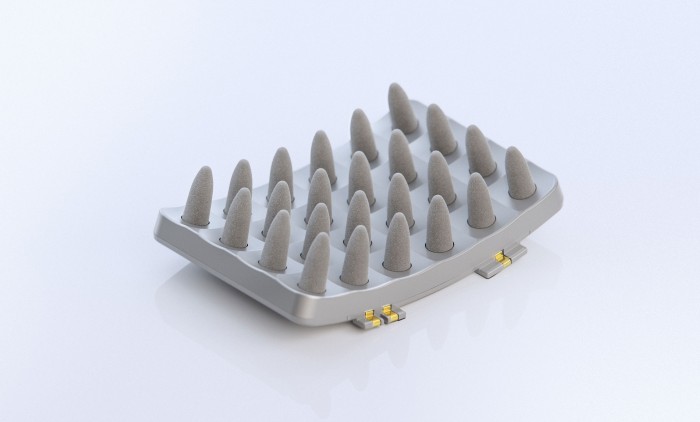Brain-Zapping Headphones Could Make You a Better Athlete
Dan Chao is an avid cyclist who likes to train on a stationary bike. Lately while training he’s been sporting a pair of trendy-looking headphones that also stimulate his brain. And he says the device has helped him improve his performance on his real bike.
Chao is a cofounder and the CEO of a startup called Halo Neuroscience, which released the neurostimulating headphones, called Halo Sport, last month. The arch of the headphones contains two electrodes that deliver a very small amount of electric current to the wearer’s head, aimed at the neurons in the motor cortex, a brain region that coördinates movement.
The mild stimulation, called transcranial direct-current stimulation, essentially makes it “slightly easier for the neurons to fire,” says Chao. In principle, that should cause them to form more new connections. Chao says the company’s research data suggests this effect can be used to help athletes get more out of their training.
In the past 15 years, scientists have shown that such mild stimulation can indeed make neurons more or less likely to fire, and they have produced some promising evidence that the technology could be used to do things like improve cognition, aid in stroke recovery, and make people better at learning motor skills. But researchers are still hotly debating whether or not it’s responsible to market the technology to consumers. Some argue that the existing science doesn’t support claims that the technology can enhance something as complicated as athleticism, and that selling consumers on the idea could be unsafe.

Halo’s early research led Chao and his colleagues to focus on using the technology to stimulate the motor cortex, and ultimately to target athletes with their first product. Chao says the company is “absolutely” aiming to publish in peer-reviewed journals.
For now, Halo has published a small amount of data on its website. In one investigation, company researchers found a correlation between transcranial direct-current stimulation and an improvement in how quickly a relatively small group of healthy volunteers could learn to play a particular sequence of piano chords. Another study concluded that when paired with practice, the technology enhanced the ability of healthy volunteers to generate force while pinching a strain gauge between the thumb and index finger. And a third study concluded that the mild neurostimulation, along with a training program, helped elite athletes improve their jumping ability.

The company, which has secured $9 million in venture capital from Silicon Valley firms including Andreessen Horowitz and Lux Capital, is offering the Halo Sport to elite athletic teams and organizations, which can buy a “service package” that includes specific training programs. Its first customer was the U.S. military.
But some scientists say marketing claims like the ones Halo is making are irresponsible because they are not grounded in peer-reviewed science. John Krakauer, a professor of neurology and neuroscience and the director of the Brain, Learning, Animation, and Movement Lab at Johns Hopkins University School of Medicine, says it’s disingenuous to claim that direct-current stimulation of the motor cortex can enhance athleticism. The role of the motor cortex in learning, much less in athleticism, is not fully understood, he says. And all of the existing peer-reviewed research has been done in controlled laboratory settings and focused on isolated, simple tasks.
It’s premature to make claims about the efficacy of this technology, argues Flavio Frohlich, a psychiatry professor at the University of North Carolina School of Medicine, because there have been very few carefully done studies involving large numbers of subjects and proper control groups. Frohlich says the technology should not be commercialized without medical oversight, since there is still a lot we don’t know about its effects on the brain, in particular over the long term.
But there is plenty of evidence suggesting transcranial direct-current stimulation is safe as long as established protocols are followed. And there is no evidence to suggest that there is long-term risk, says Marom Bikson, a professor of biomedical engineering at City College of New York, who runs his own company that sells devices based on the technology to researchers.
Chao acknowledges that the physiology of athleticism is complicated, and says Halo is only claiming its device can provide benefits when paired with rigorous training. It’s just “one tool in an athlete’s tool chest,” he says. “You still have to put in the work.”
Deep Dive
Humans and technology
Building a more reliable supply chain
Rapidly advancing technologies are building the modern supply chain, making transparent, collaborative, and data-driven systems a reality.
Building a data-driven health-care ecosystem
Harnessing data to improve the equity, affordability, and quality of the health care system.
Let’s not make the same mistakes with AI that we made with social media
Social media’s unregulated evolution over the past decade holds a lot of lessons that apply directly to AI companies and technologies.
Stay connected
Get the latest updates from
MIT Technology Review
Discover special offers, top stories, upcoming events, and more.